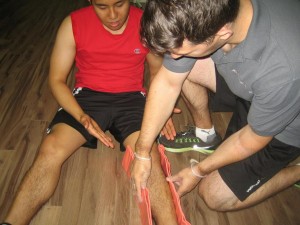CPR training in Portland has been popular among allied health students, providers, and professionals over the years but it has only been recently made available to the public. The latest set of CPR guidelines was released by the American Heart Association was the 2010 Basic Life Support guidelines, used by rescuers when giving CPR in or out of the hospital.
If you need certification for CPR or first aid training, you can enroll in any of our basic or advanced classes! We give students training credentials once they finish the class with (1) complete attendance and (2) a pass on the certification test.
Addressing Cardiac Arrest: CPR Strategies
Cardiac arrest is a condition where the heart stops beating completely. It can be due to a heart attack or severe arrhythmia – either way, the heart fails to function adequately to meet the needs of the body. CPR is considered first line management for cardiac arrest. This means that whatever the situation, CPR is always performed first.

Untrained lay (non-medical) rescuer
- Untrained lay rescuers are expected to perform only chest compressions. This is called “Hands-only CPR”. They should compress the chest hard and fast, with both hands pressing down in the middle of the chest, between the nipples. Likewise, a rescuer can call dispatch and follow their instructions in giving CPR.
Trained lay rescuer
- Trained lay rescuers should be able to provide correct chest compressions at a minimum. That means they are using the proper posture, hand position, rate, and compression depth as CPR is being performed. If they are comfortable (and/or confident) enough, they should give ventilations through rescue breaths, at a ratio of 30:2 (compression to ventilation).
Healthcare provider
- Outside of a hospital, the most a bystander health care provider do is give adequate compressions and ventilation. In the case that an automated external defibrillator is available, the HCP can provide defibrillation as needed. Defibrillation is used only in cases of severe arrhythmia, to return the heart to its normal rhythm.
The Chain of Survival
The 2010 guidelines are made up of five consecutive steps:
- Recognition of SCA (sudden cardiac arrest)
- Starting chest compressions and ventilation
- Defibrillation with an AED
- Advanced Life Support
- Post-cardiac arrest care
These steps are followed by rescuers, whether they are lay persons or HCPs or whether the arrest happens in or out of a hospital. You can view the complete guidelines on the AHA journal website’s 2010 AHA CPR and Emergency CV Care publication.
Available Classes in CPR/first aid
Classes are Portland CPR range from 4 hours to 16 hours. Basic classes are shorter and advanced classes are longer, taking two days to complete all the lessons.
- Advanced Cardiac Life Support
- Pediatric Advanced Life Support
- Basic Life Support for HCPs
- Heartsaver C (HCPs)
- Heartsaver (lay persons/general public)
Certificates from the programs listed are valid for 24 months before they have to be renewed,
